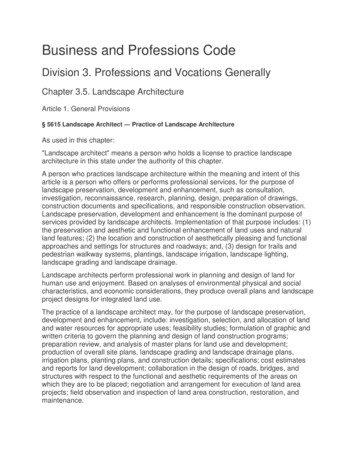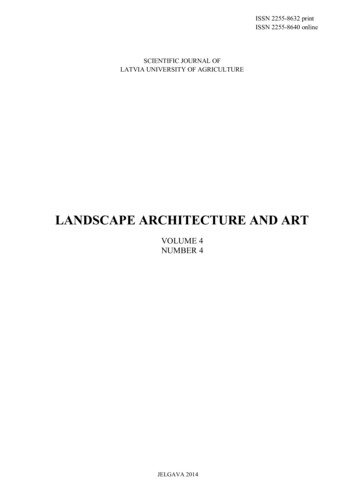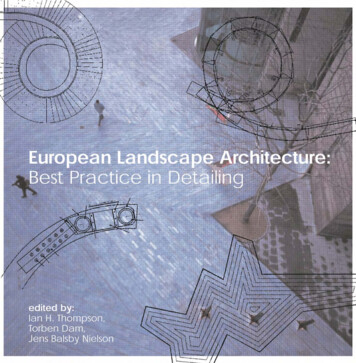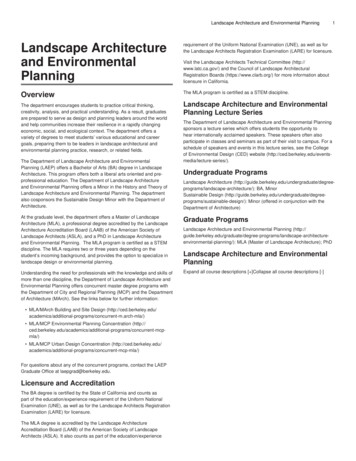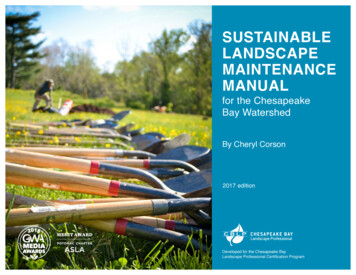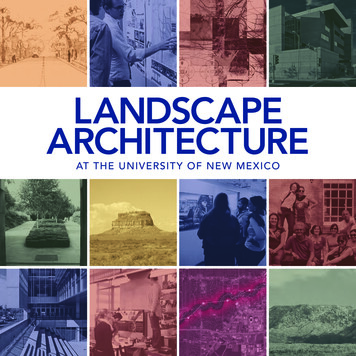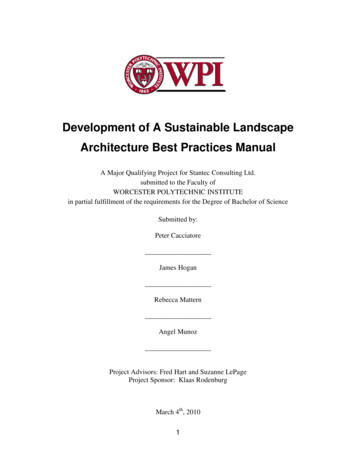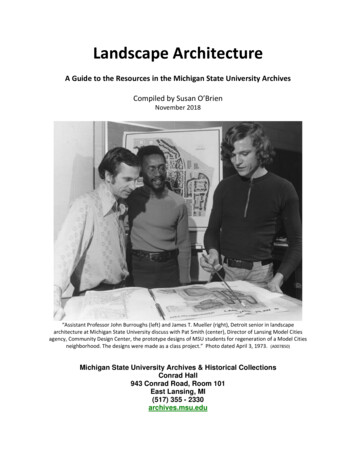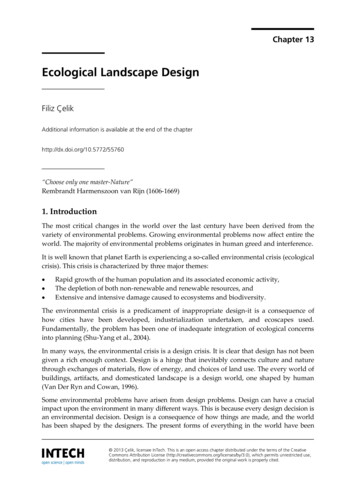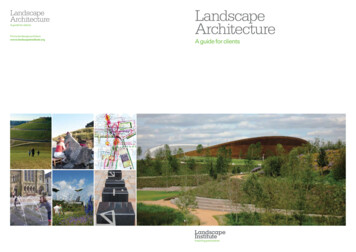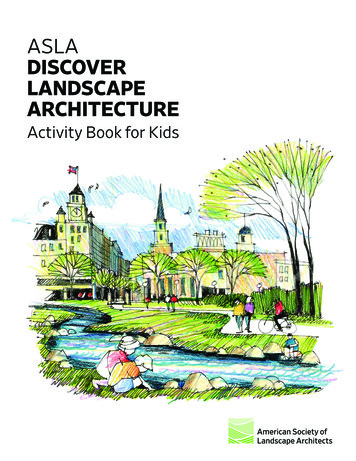
Transcription
ASLADISCOVERLANDSCAPEARCHITECTUREActivity Book for Kids
ASLA Discover Landscape ArchitectureActivity Book for Kids American Society of Landscape Architects. All rights reserved.IntroductionThe ASLA Discover Landscape Architecture Activity Book for Kids is for anyone ages 9–12 who is interested inlandscape architecture, architecture, planning, and engineering, and for those who like to draw, doodle, and beinspired. The book’s primary focus is landscape architecture, giving readers the opportunity to see and sketchthe many drawings, places, and landscapes created by landscape architects.About ASLAFounded in 1899, the American Society of Landscape Architects (ASLA) is the professional association forlandscape architects in the United States, representing more than 15,000 members.Vision: Leading the design and stewardship of land and communities.Mission: Landscape architects lead the stewardship, planning, and design of our built and naturalenvironments. The Society’s mission is to advance landscape architecture through advocacy, communication,education, and fellowship.Cover: James Richards, FASLAKiley and Friends: Suehyun Choi, Student ASLA2
ASLA Discover Landscape ArchitectureActivity Book for KidsHello! My name is Kiley, and I am so excited you have joined me on a journey throughmy favorite place on earth. What is this place, you ask? It’s my hometown, betterknown as Oakville. I am thrilled to teach you about the great places designed by myfriends who are landscape architects.In this activity book, you will learn about landscape architecture, see sketchesfrom real landscape architecture professionals, and have the opportunity to sketchand color drawings. Before starting our journey, flip to the next page to learn whylandscape architecture is important and make sure to gather the materials you willneed to get started.3
What is landscape architecture,and why is it important?Landscape architecture combines art, science, and technology. It is a diverseprofession that designs, plans, and manages the places we live and enjoy. Landscapearchitects design projects that contribute to the design of healthy environmentsand communities. Below are some goals that landscape architects achieve in designprojects.Make Places for PeopleParks, gardens, playgrounds, town squares, and wilderness are among theplaces landscape architects design.Health and SafetyLandscape architects design places to be safe and accessible to all people byproviding areas to walk, to sit, to play, to exercise, and to explore.Better NeighborhoodsLandscape architects can help make sure that parks, playgrounds, schools, andstores are a pleasant walk from home.Cleaner WaterLandscape architects work on ways to prevent pollution from entering ourstreams and rivers by providing rain gardens where water can soak back intothe ground and filter out pollution by using soil and plants.Better StreetsLandscape architects design streets to accommodate all kinds of people—those on foot, on bikes, in wheelchairs, waiting for the bus, and even in cars.4excerpt from Landscape Architecture Magazine’s YOUR LAND
What materials will you need?Now that you have learned about landscape architecture, check out some of thematerials that you will need as you work through the book. Once you’ve had a chance tocollect your materials, it’s time to join me and my friends on a journey through lerPencil SharpenerEraser5
Welcome to Oakville!Welcome to my home! This is the best place ever because it has amazing outdoor spacesfor me to jump around and hang out with friends. I give all of the credit to the landscapearchitects and other professionals who helped design and build these spaces.Can you think of a place in your hometown that may have been designed by a landscapearchitect? If you need a little help, check out some of the fun places in Oakville thatwere designed and built for our community.gardenspondsWho drew that?Gardens: Jessica Nielsen, Student ASLAPonds: Chip Sullivan, ASLAPlaygrounds: Richard Alomar, ASLATown Squares: David Sprunt, ASLA6
playgroundstown squares7
Discover how Oakvillewas designed and built!Oakville was not always like it is today. It took a lotof time and hard work by landscape architects todesign the outdoor spaces, and for the builders tofollow the drawings to build the projects so they’regood for you as a person, but also for me as a frog.To the right is a plan drawing of Oakville. A plandrawing is used to show the design of a place as ifyou were viewing it from an airplane looking down.So, by looking at the plan, act as if you are flyingover the town and looking down. Can you find thefollowing building blocks in the plan drawing?Lily PondFlowers100-year-oldOak TreesFountainRain geTreeStumps
townsquareparkgardensndgrouplaypondldathletic fieneighborhood9
Now let’s learn more about the building blocks that landscape architects use!PlantsPlants keep us alive as food and fuel. They turn sunlightand carbon dioxide in the air into energy, and pump oxygeninto the atmosphere for us to breathe. Plants provide shade,shelter, and food for animals. They can help clean and soakup water and also look and feel great.All kinds of plants, from mosses and grasses to shrubs andtrees, are important for landscape architects. In the sketchbelow, a tropical garden was designed for someone’s house.Who drew that?Natalia Almonacid, Student ASLAAuburn, Alabamaering thbotrloAdd co ing to life!draw10excerpt from Landscape Architecture Magazine’s YOUR LAND
Who drew that?Katarina Katsma, ASLAChicago, IllinoisKatarina’s three favorite things about her job are working with people to come up with a design,problem-solving a tricky landscape, and positively affecting the lives of communities.Can you tell the differencebetween these plants? Whereare the trees, shrubs,and vines?11
WaterWater covers 70 percent of the earth’s surface, so it is animportant part of most landscapes, whether in the form ofoceans, lakes, rivers, or streams. There is also a lot of water,known as groundwater, stored deep in the earth where wecan’t see it. Water helps nourish the land and is required fornearly all forms of life.Landscape architects use water for a variety of projects.They design human-made water elements such as fountainsand also help restore natural waterways such as streamsand rivers. In the sketch below, water was used to design afountain in the town square.Who drew that?David Sprunt, ASLALittleton, Coloradoering thbotrloAdd co ing to cerpt from Landscape Architecture Magazine’s YOUR LAND
Who drew that?James Richards, FASLASarasota, FloridaJames is a landscape architect because the profession brings together the interests and skills heloves most. These include problem-solving, art, physical sciences, psychology, writing, and somany other subjects that can make a tremendous difference in the world.Complete the drawing byadding color to the streamand boulders.13
SoilSoil sustains life on land. It may be sandy like a beachor hard like clay. It contains minerals, water, gases, andorganic matter that feeds plants through their roots. Soilalso holds billions of tiny organisms, such as bacteria andfungi, that build a complex web of life under the surface.Worms and bugs crawl around in the soil, eating andmoving nutrients around.It’s important for landscape architects to understandsoils to ensure healthy plants. In the sketch below,healthy soils were used to help grow vegetables.Who drew that?Shawn M. Balon, ASLARichmond, Virginiacarrotradishtopotaring thebotrolAdd coto life!drawing14excerpt from Landscape Architecture Magazine’s YOUR LAND
Who drew that?Dan Li, Student ASLABlacksburg, VirginiaDan’s three favorite things about her job are that it keeps an exciting balance between art andscience, puts her creativity and imagination to work, and solves real-world problems.This drawing shows four layersbelowground. Can you matcheach name with the correct layer?Complete the drawing by coloringeach layer with different colors.Layer Namesrockstopsoilclaysand15
MaterialsLandscapes are made of many different materials. Theyinclude natural materials such as soil, plants, and water,as well as stone, wood, and mulch. They may also includehuman-made materials like concrete, brick, steel, glass,and even fabrics.Landscape architects use a variety of materials to buildplaces and landscapes. For example, concrete can beused to build sidewalks, and wood can be used to builda bench. In the sketch below, tree stumps were used tocreate places to sit and climb.Who drew that?Gregory Miller, FASLA,2017–2018 ASLA PresidentAlbuquerque, New Mexico16ng theirbotlorAdd co ing to life!drawexcerpt from Landscape Architecture Magazine’s YOUR LAND
Who drew that?Yuki Igarashi, Student ASLADavis, CaliforniaYuki discovered landscape architecture when she met the landscape architect who designed herhigh school’s quad. She never put much thought into designing open spaces, and that experiencechanged the way she started to understand space.Complete the drawing byadding materials for kids touse for walking and playing!stone wallconcreteplantingseston17
Discover the building blocksCongratulations! You have now learned four of the building blocks that landscapearchitects used to design my favorite places in Oakville. Now, let’s see how theywere used in the park. Can you find the four building blocks (plants, water, soil, andmaterials) in the sketch below?18
Once you have discovered all of the building blocks in the sketch to the left, use yourcreative skills to redraw them below.waterplantssoilmaterialsWho drew that?Michael Batts, ASLARaleigh, North CarolinaMichael’s three favorite things about his job are drawing, creating new places that no one hasever seen before, and collaborating with different people to develop fun ideas.19
Check your answers!streetreesroundplaygipmentequplaygrouslide ndconcrete pavingplantingwaterwaterbouldersconcrete pavingbridgentainr fouwateplanand tingsoilstone wallwater20
Design your own park!Now that you have learned about the different places in Oakville, it’s your turn todesign a park for the community to enjoy. Design the park around the stream below,and don’t forget to include the four building blocks.21
Design your own playground!Draw a playground where kids can run, climb, and play. Design the playgroundaround the beautiful planting below, and don’t forget to include the four buildingblocks.22
Design your own town square!Draw a fun town square where kids and families can visit. Design the town squarearound the water fountain below, and don’t forget to include the four building blocks.23
Design your own garden!Draw a garden with plants and artistic sculptures where communities can visitand relax. Design the garden around the arch and sidewalk, and don’t forget toinclude the four building blocks.24
Design your own pond!Draw a fun pond with lily pads and other plants where frogs and birds can call home.Design the pond around the plants and water, and don’t forget to include the fourbuilding blocks.25
Your turn!Become a Landscape ArchitectIf you love the outdoors, care about the environment, love working with people, enjoy problemsolving, and are creative, you can become a landscape architect!Study HardPrepare by studying science, technology, art, math, history, and business. Landscapearchitecture relies on a lot of STEM (Science, Technology, Engineering, Mathematics)skills you may already be learning.Visit a Landscape ArchitectAlmost every community has landscape architects working in it to improve the quality oflife. Try to get to know one and pay her or him a visit. You can also contact your nearestlocal chapter of the American Society of Landscape Architects to ask for more informationabout projects in your community.VolunteerGet to know your surroundings by taking part in community events. Join a cleanup day atyour local park or help clean trash from a stream. Visit nature centers and join in on naturewalks through your community—there is a lot to discover!Prepare for CollegeTo become a landscape architect, you will first enroll in a landscape architecture programat a college or university. There are many landscape architecture programs in the UnitedStates.26excerpt from Landscape Architecture Magazine’s YOUR LAND
Thank you to the following ASLA members who shared their talentsto help develop the Activity Book for Kids:Natalia Almonacid, Student ASLARichard Alomar, ASLAShawn M. Balon, ASLAMichael Batts, ASLASuehyun Choi, Student ASLAYuki Igarashi, Student ASLAKatarina Katsma, ASLADan Li, Student ASLAGregory Miller, FASLAJessica Nielsen, Student ASLAJames Richards, FASLADavid Sprunt, ASLAChip Sullivan, ASLA27
For more information visit:asla.org/yourpath American Society of Landscape Architects. All rights reserved.
The ASLA Discover Landscape Architecture Activity Book for Kids is for anyone ages 9–12 who is interested in landscape architecture, architecture, planning, and engineering, and for those who like to draw, doodle, and be inspired. The book’s primary focus is landscape archi
